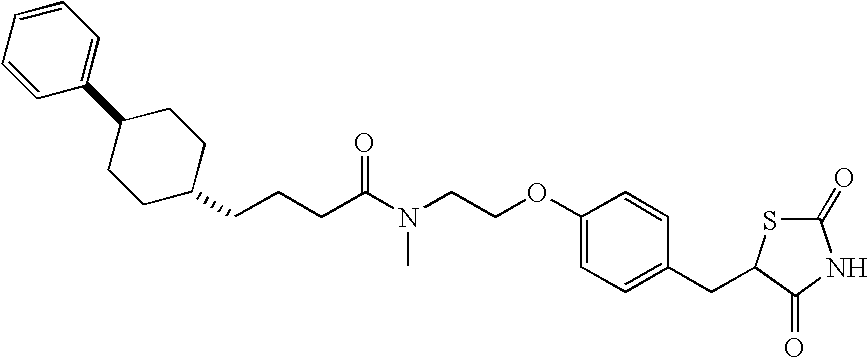Design and synthesis of optimized ligands for PPAR
a technology of ppar and ppar activator, applied in the field of rational drug design, can solve the problems of ppargamma activator not being useful for acute inflammation treatment, and the anti-inflammatory effect of ppargamma is controversial
- Summary
- Abstract
- Description
- Claims
- Application Information
AI Technical Summary
Benefits of technology
Problems solved by technology
Method used
Image
Examples
example 1
Method for Evaluating the Activity of Compounds Developed Using this Invention—Binding Assay
[0196]For the binding assay, bacterial expression plasmids for the ligand binding domains of the PPAR subtypes, cDNAs encoding the hinge and ligand binding domains of hPPAR (amino acids 167-468), MPPAR (amino acids 167-468), xPPAR (amino acids 174-474), and xPPAR (amino acids 178-477) are obtained. GST-PPAR fusion proteins or glutathione S-transferase (GST) alone as a control are expressed in BL21(DE3) plysS cells and extracts prepared by freeze-thawing the cells in bacterial lysis buffer (10 mM Tris, pH 8.0 / 250 mM KCl / 1 mM DTT / 1% Triton X-100) followed by centrifugation at 40,000×g for 30 min. Glycerol is added to the bacterial extracts to a final concentration of 10%. Bacterial extracts are dialyzed extensively against bacterial lysis buffer containing 10% glycerol to remove glutathione that might interfere with the stability of the various FAs and eicosanoids in the competition binding ass...
example 2
Method for Evaluating PPAR Activity of the Compounds of this Invention Using a Transactivation Assay or FRET Assay
[0198]The binding of agonist ligands to a nuclear receptor results in transactivation, i.e., changes in the expression level of mRNAs encoded by PPAR target genes. Cell-based assays have been developed which monitor this functional activity. Transactivation assays use cells that have been transfected with a vector expressing the receptor as well as a second vector containing a DR-1 response element and a reporter gene, which encodes an enzyme such as chloramphenicol acetyltransferase, secreted placental alkaline phosphatase (SPAP), or firefly luciferase. Activation of the receptor by agonist ligands leads to induction of reporter enzyme expression, which can be conveniently assayed using standard colorimetric or photometric plate readers.
[0199]In the case of PPARs, an ideal assay is the PPAR-GAL4 transactivation assay using chimeric receptors where the PPAR LBD is fused ...
example 3
Method for Screening for Compounds that Modify the Activity of PPARgamma and PPARalpha Based on Inhibition of NF-kappaB Activation
[0202]Compounds are tested for the ability to inhibit activity of NF-kappaB. Human endothelial cells and vascular smooth muscle cells (VSMC) are known to express both PPARgamma and PPARalpha (Neve B P, et al. Biochem Pharmacol. 2000; 60:1245-1250). Alternatively, isolated human peripheral T lymphocytes from normal healthy donors or a mammalian cell line such as a Jurkat T cell line transfected with the PPARalpha and / or the PPARgamma expression vector may be used in these experiments. One of these selected cell types is stimulated with a concentration of one or a combination of: phytohemagglutinin / phorbol-12-myristate-13-acetate (PHA / PMA), TNF-alpha, interferon-gamma or some other factor that activates NF-kappaB. Activation of NF-kappaB is determined by electrophoretic mobility shift assay similar to that previously described (Rossi A, et al. Proc Natl Aca...
PUM
| Property | Measurement | Unit |
|---|---|---|
| concentration | aaaaa | aaaaa |
| concentration | aaaaa | aaaaa |
| concentration | aaaaa | aaaaa |
Abstract
Description
Claims
Application Information
 Login to View More
Login to View More - R&D
- Intellectual Property
- Life Sciences
- Materials
- Tech Scout
- Unparalleled Data Quality
- Higher Quality Content
- 60% Fewer Hallucinations
Browse by: Latest US Patents, China's latest patents, Technical Efficacy Thesaurus, Application Domain, Technology Topic, Popular Technical Reports.
© 2025 PatSnap. All rights reserved.Legal|Privacy policy|Modern Slavery Act Transparency Statement|Sitemap|About US| Contact US: help@patsnap.com



